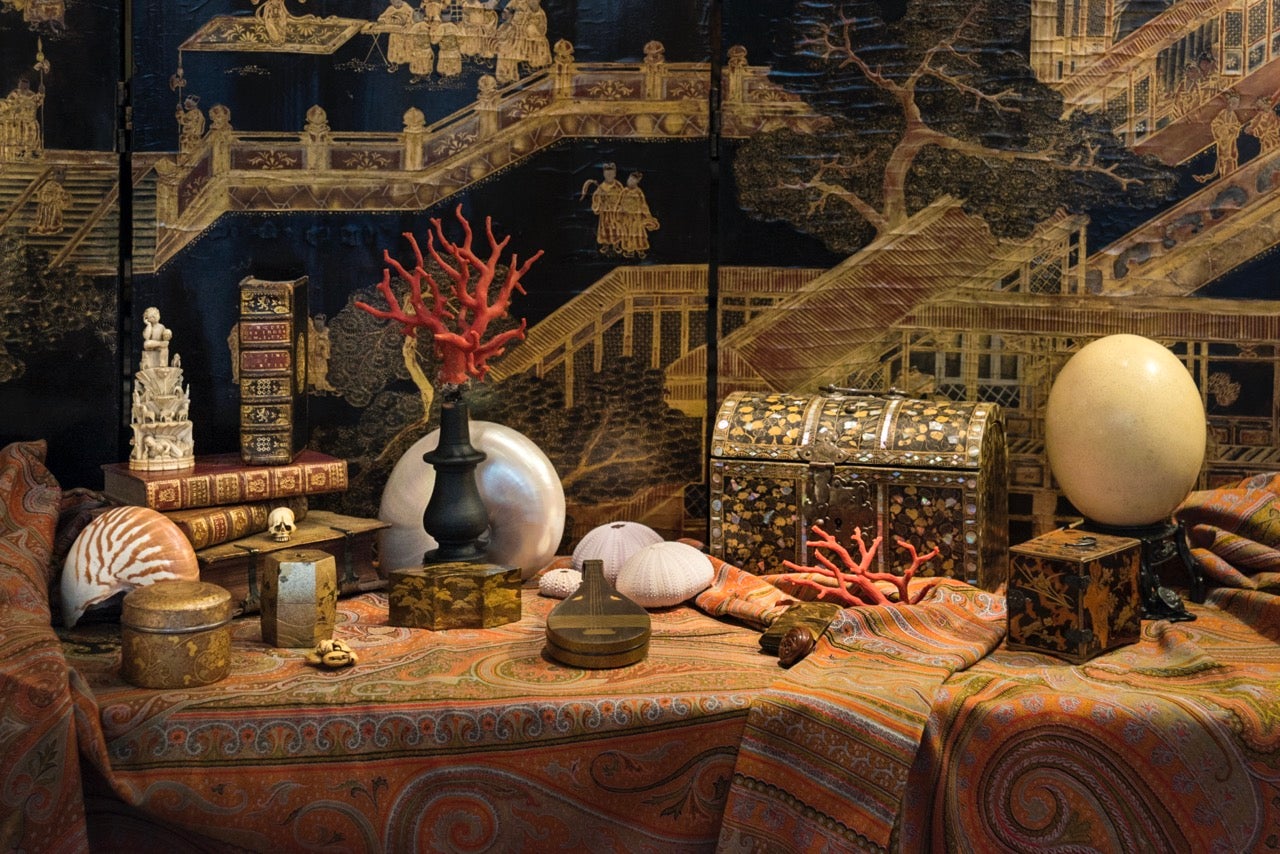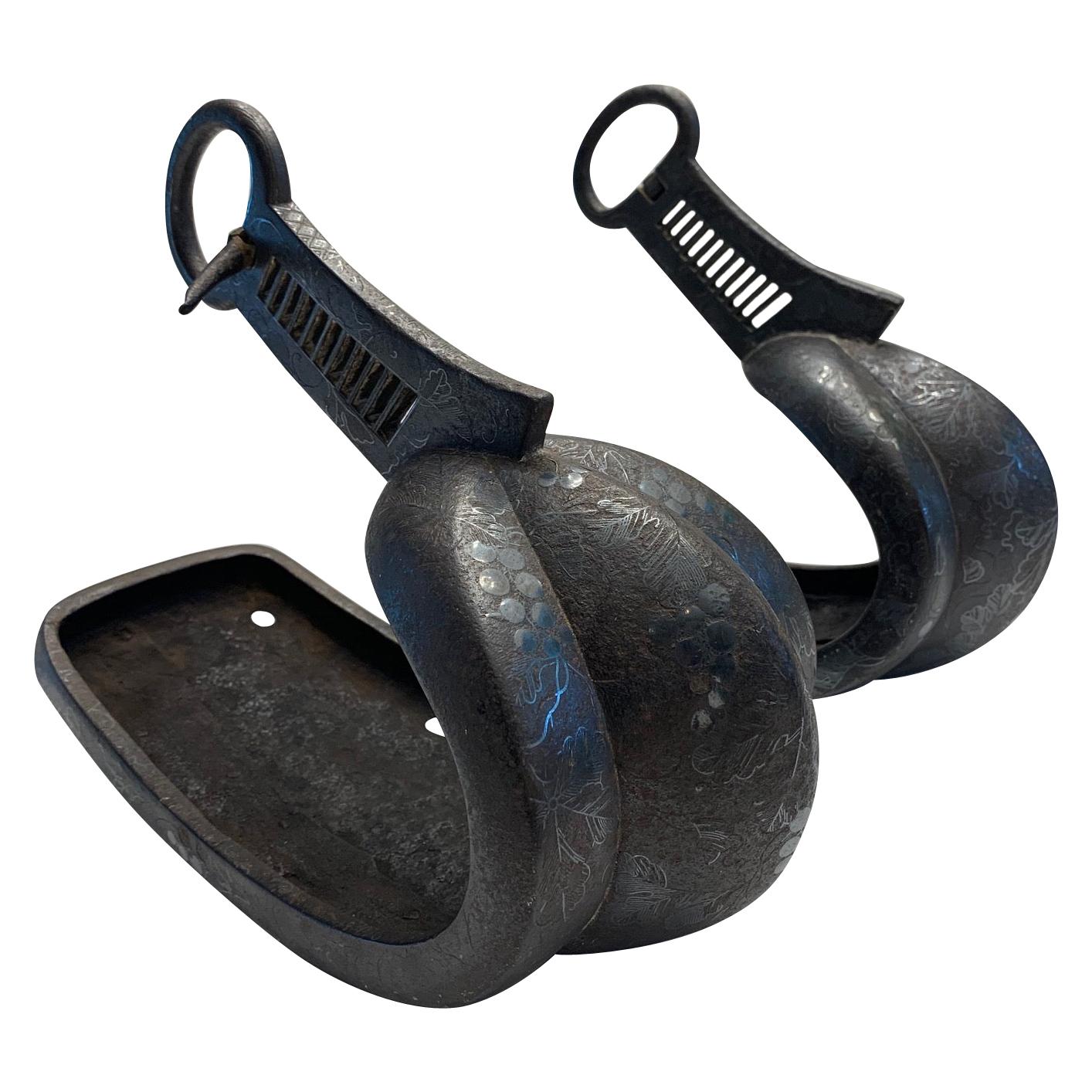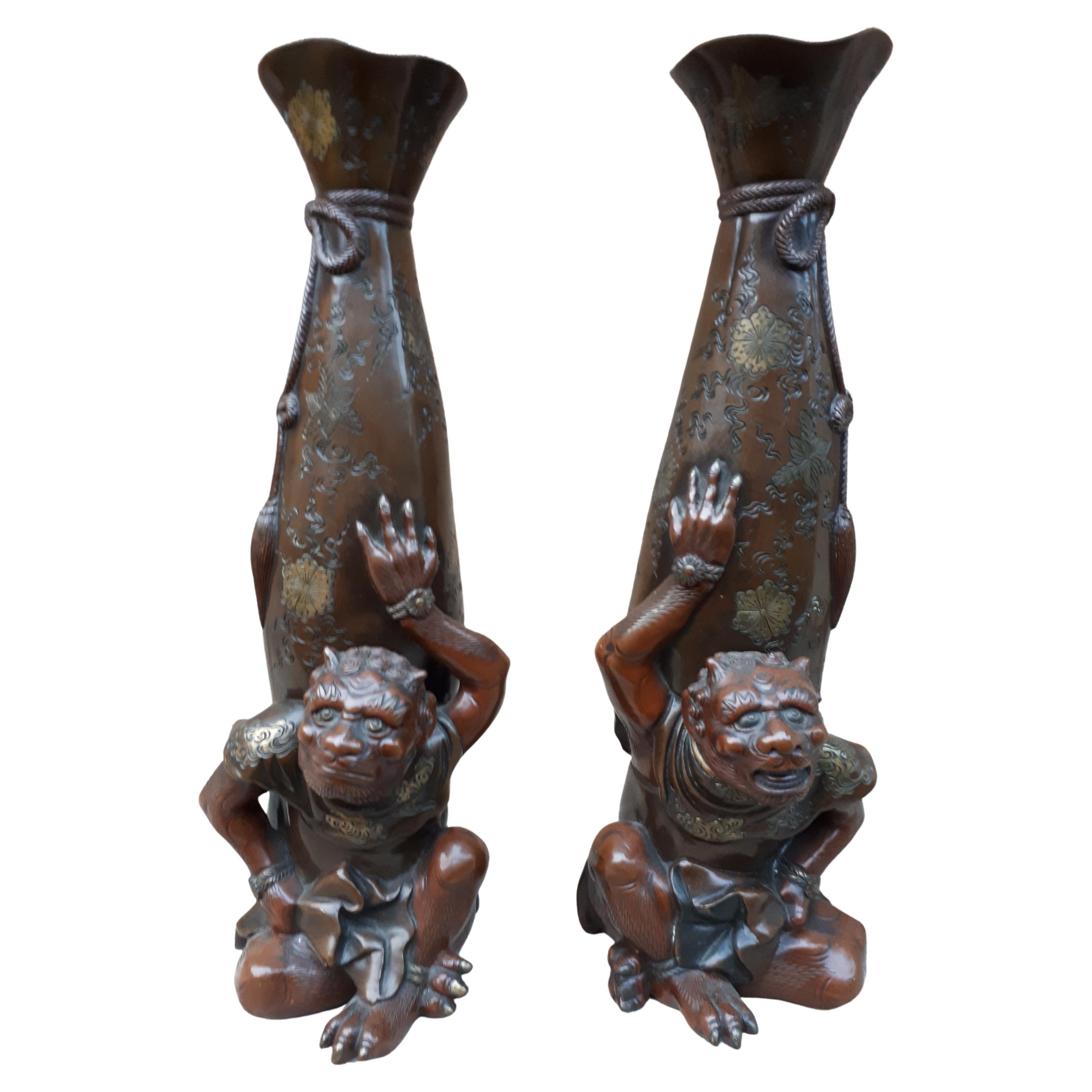Items Similar to Pair of Japanese Abumi Stirrups
Want more images or videos?
Request additional images or videos from the seller
1 of 9
Pair of Japanese Abumi Stirrups
About the Item
Pair of stamped brass stirrups decorated with Hashizuka, Ito and Manabe Mons.
Japan - Edo (1615-1868), 18th century.
Height: 10.24 in. (26 cm), length: 12.6 in. (32 cm), width 4.72 in. (12 cm)
As in Western culture, the culture Japanese stirrups were part of traditional accessories used only by the nobility and the people belonging to the upper class. The stirrups were made in the most precious metal, they were intended to indicate the social status of the owner.
They were used in military combat during ceremony or daily. The traditional form of Japanese calipers take its source in the Heian period (Between 794 and 1185). During the Momoyama period some helmets and armor reflect the influence of Iberian armament but the shape of the Japanese stirrups remained unaltered. The arrival of the Portuguese in the archipelago had an impact at another level. The decoration is different. Because these pieces are melted in iron, they are highly resistant and also thoughts as powerful weapons. Volume and frontal prominence guaranteed considerable damage to their enemies especially when they were without frames. The presence of ganches proves that these calipers were manufactured by or for the Portuguese. The ganche being absent from the Japanese stirrups.
- Dimensions:Height: 10.24 in (26 cm)Width: 4.73 in (12 cm)Depth: 12.6 in (32 cm)
- Sold As:Set of 2
- Materials and Techniques:
- Place of Origin:
- Period:
- Date of Manufacture:1615-1868
- Condition:Wear consistent with age and use.
- Seller Location:PARIS, FR
- Reference Number:

About the Seller
No Reviews Yet
Vetted Seller
These experienced sellers undergo a comprehensive evaluation by our team of in-house experts.
Established in 2013
1stDibs seller since 2023
- ShippingRetrieving quote...Ships From: PARIS, France
- Return PolicyA return for this item may be initiated within 7 days of delivery.
More From This SellerView All
- Pair of Japanese Bronze Grasshopper VasesLocated in PARIS, FRInsects (mushi) occupy an important place in Japanese culture. Hunting for insects is a popular pastime, especially among children. Using plastic nets and cages, they catch cicadas and beetles to observe them. Between 1830 and 1832, Hokusai composed an untitled series of ten large horizontal prints...Category
Antique Late 19th Century Japanese Metalwork
MaterialsBronze
- Japanese Bronze Group of Mice, Pumpkin and PomegranateLocated in PARIS, FRPolychrome bronze of a group of mice around a pumpkin and a pomegranate. The five mice have a dark brown patina, while the hollowed-out gourd is dark brown and the split pomegranate ...Category
Antique Late 19th Century Japanese Metalwork
MaterialsBronze
- Japan chrysanthemum tsubaLocated in PARIS, FRIron tsuba in the shape of a chrysanthemum (kikugata), openworked in negative with foliage and geometric patterns. Chrysanthemum shaped tsuba were quite popular in the Edo period as...Category
Antique Mid-18th Century Japanese Metalwork
MaterialsGold, Iron
- Japanese Bronze KappaLocated in PARIS, FRDark brown patina bronze figure of a standing kappa with its right leg leaning on a cucumber. The figure is put on four-legged rattan-like bronze stand. The kappa (??) is a aquati...Category
Antique Late 19th Century Japanese Metalwork
MaterialsBronze
- Japanese Bronze Hawk IkebanaLocated in PARIS, FRBronze intended for hanging (? dô kakenanaike, « hanging bronze ») depicting a hawk, placed on a branch. The inside is hollow so a bouquet a flowers can be put inside and thus, serve...Category
Antique Late 19th Century Japanese Metalwork
MaterialsBronze
- Japan mice treasure bag MeijiLocated in PARIS, FRJapanese bronze representing two mice, one of them pulling a treasure bag. The mouse or the rat (both called nezumi in Japanese), one of the zodiac signs, is a symbol of fortune. T...Category
Late 20th Century Japanese Japonisme Metalwork
MaterialsBronze
You May Also Like
- Pair of Japanese Abumi Samurai Stirrups with Dragons, c. 1800Located in Chicago, ILInlaid with brass and silver, this extraordinary pair of Japanese bronze stirrups, known as Abumi, were crafted in the Edo period (1603-1868) for use on a Samurai's horse. Each is wo...Category
Antique Early 19th Century Japanese Edo Metalwork
MaterialsSilver, Bronze, Iron
- Pair of Japanese Edo Period Iron Silver Inlaid Red Lacquered Stirrups 'Abumi'Located in New York, NYA Pair of Japanese Edo Period (1603–1867) iron, silver inlaid, and red lacquered stirrups (Abumi). Each of typical form, made of iron with silver inlay on the front with floral bloss...Category
Antique 1690s Japanese Edo Metalwork
MaterialsSilver, Iron
- 18th Century Japanese Silver Inlaid Iron Shogun Stirrup (Abumi) Red LacquerLocated in Stamford, CT18th century iron abumi of typical form, the stirrup inlaid in silver, an encircled peony flower crest surrounded with a geometric pattern, the interior retains the original wood lin...Category
Antique Early 18th Century Japanese Edo Metalwork
MaterialsSilver, Iron
- Antique Japanese Iron Stirrups with Silver Inlay SignedLocated in Atlanta, GAA pair of antique Japanese Abumis, stirrup for horse-riding, in cast iron with elaborate silver inlay, circa 16th century Muramachi to Momoyama period. The prototype of Japanese abum...Category
Antique 16th Century Japanese Japonisme Metalwork
MaterialsSilver, Iron
- Pair of Japanese Bronze Vases, Japan Meiji PeriodLocated in Saverne, Grand EstExtraordinary pair of chiseled bronze vases with multiple patinas in the form of an oni seated cross-legged supporting the body of each vase in the shape of a purse. Work similar to ...Category
Antique Late 19th Century Japanese Metalwork
MaterialsBronze
- Pair of Japanese Brass CandlesticksLocated in Stamford, CTA fine pair of small beautifully made Japanese brass candlesticks with delicate silhouettes. The four curving legs on a round base supporti...Category
Antique Late 19th Century Japanese Meiji Metalwork
MaterialsBrass
Recently Viewed
View AllMore Ways To Browse
Cast Iron Japanese Tea Kettles
Antique Cast Iron Water Kettle
Cloisonne Fish Bowl
Japanese Chocolate Set Antique
Antique Sprinkler Bottles
Champleve Censer
Tiffany China Bowl
Yemeni Jambiya
Antique Japanese Saki
Chinese Dragon Costume
Vintage Arabic Coffee Pot
Antique Indian Spice Tin
Brass Rose Water Sprinkler
Chinese Copper Teapot
India 19th Century Hand Etched Brass Vase
Japanese Belt Buckle
Kulah Khud
Quicksilver Antiques





